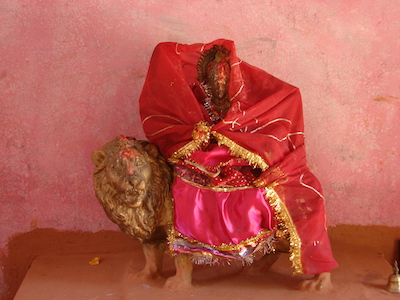
Chaitra Navaratri is from 2nd April to 11th April 2022
Prathamam Shailaputri ca dvitiyam brahmacharini |
Tritiyam chandra ghanteti kusmandeti chaturhakam ||
Panchamam skandamaateti shashtam katyayaniti ca |
Saptamam kalaratriti mahagauriti chastamam ||
Navamam siddhidatri ca navadurgah prakiritah |
Uktanyetani namani brhmaniva mahatmana ||
Katyayani Vidmahe
Kaniyakumari cha Dhimahi
Tanno Durge Prachodayat
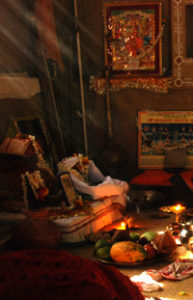 Pranam to Devi, to Shakti who manifests, and is in all, in the form of intelligence, wisdom, compassion, beauty, abundance, who is the consort of Lord Shiva, who creates, sustains and destroys the universe.
Pranam to Devi, to Shakti who manifests, and is in all, in the form of intelligence, wisdom, compassion, beauty, abundance, who is the consort of Lord Shiva, who creates, sustains and destroys the universe.
Lord Shiva, unchanging, motionless, unaffected by the cosmic play is the witness. Shakti is the Cosmic Energy, the power of manifestation. Sans Shiva, Durga has no existence. Sans Durga, Shiva is without expression. Durga is identical with Shiva.
In the Kena Upanishad, it is said: “When Brahman is known as the Self of cognition, in every state of consciousness, It is known in reality. Thus one attains immortality.”
When the gods thought that the victory is ours and the glory is ours, Brahman appeared in the form of a yaksha, and withdrew the power, for the victory of the gods is the victory of Brahman alone. Uma, the Divine Mother, reveals this Truth of Brahman to Indra, ruler of the Heavens, and to the gods.
This Truth is known in the flash of lightning, in the blink of the eye, and remembered by the mind.
Of this knowledge, austerity, self-restraint and action are the feet, the Vedas are the limbs and Truth is the abode.
Worship of Devi is adoration of Brahman, in praise of the glory of the Divine. Swami Sivananda Saraswati said, “The Mother’s Grace is boundless. Her mercy is illimitable; Her knowledge infinite; Her power immeasurable; Her glory ineffable; and Her splendour indescribable.”
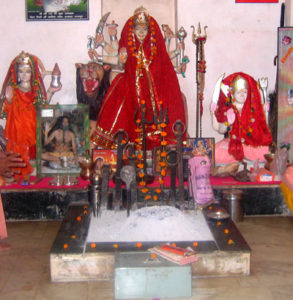 Commonly observed, Rama Navaratri is during the first nine days of the bright fortnight of the Hindu lunar month Chaitra (March/April). And Durga Navaratri is during the first nine days of the bright fortnight of the Hindu lunar month Aswayuja/Ashwin (Sept/Oct). The festival is celebrated in honour of the nine manifestations of Durga. Beginning of summer and beginning of winter are two conjunctions in nature when the external changes bring about a change in the environment and consequently in us. Navaratri is observed variously according to local customs throughout India. It is with the singular aim of propitiating and worshiping Shakti, to bestow abundance, well-being, sacred and secular knowledge, and all other potent powers.
Commonly observed, Rama Navaratri is during the first nine days of the bright fortnight of the Hindu lunar month Chaitra (March/April). And Durga Navaratri is during the first nine days of the bright fortnight of the Hindu lunar month Aswayuja/Ashwin (Sept/Oct). The festival is celebrated in honour of the nine manifestations of Durga. Beginning of summer and beginning of winter are two conjunctions in nature when the external changes bring about a change in the environment and consequently in us. Navaratri is observed variously according to local customs throughout India. It is with the singular aim of propitiating and worshiping Shakti, to bestow abundance, well-being, sacred and secular knowledge, and all other potent powers.
It is said that in days of yore, when Prince Sudarshan was ascending the Kosala throne of his dead father, a prolonged ascendancy battle ensued. Prince Sudarshan supported by his maternal grandfather, of Kalinga Raj lost to Satrujit, whose maternal grandfather was of Ujjain Raj. After Satrujit was crowned King at Ayodhya, the capital of the Kosala kingdom, Sudarshan was compelled to take refuge in Rishi Bharadwaj’s ashram. Here, the king of Kashi (Benares) met Sudarshan, and after the swayambar for his daughter Shashikala, Sudarshan and Shashikala were married.
It is said that Devi, pleased by Sudarshan’s worship, Herself commanded the Vasanta Navaratri worship which was conducted by Sudarshan, his wife Shashikala and father-in-law, Kashi Raj. Thereafter, with the defeat of Satrujit and his grandfather, Rishi Bharadwaj crowned Sudarshan as Ayodhya Raj. Their descendants continued the tradition of observance of Vasanta Navaratri, also known as sakal navaratri, initiated by Devi herself.
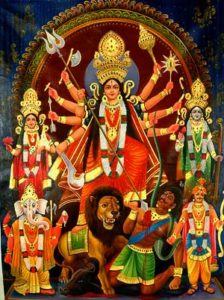 Later descendants, Sri Rama and Lakshmana continued to worship Devi during the spring Navaratri. And it is said that Devi’s blessings led to Sri Rama’s victory over Ravana. Before Sri Rama went to battle with Lanka Raj Ravana, he worshipped Devi during the Ashwin Navaratri also known as akal Navaratri.
Later descendants, Sri Rama and Lakshmana continued to worship Devi during the spring Navaratri. And it is said that Devi’s blessings led to Sri Rama’s victory over Ravana. Before Sri Rama went to battle with Lanka Raj Ravana, he worshipped Devi during the Ashwin Navaratri also known as akal Navaratri.
In remembrance and faith of the auspicious time-worn victory of good over evil, both the spring and autumn Navaratri continue to be observed by practitioners. Through ritual worship of Devi, in both Vedic and Tantric traditions. With austerity and spiritual discipline in puja and Havana, mantra japa of Devi’s Navarna Mantra , and mantras of tutelary deities. Also, recitation of the Devi Bhagwatam, Durga Saptashati, Sri Lalita Sahasranama and/or other recitations of the names of Devi, and other traditions.
It is believed that Devi herself fought Bhandasura for nine nights and killed him on the evening of the tenth day, known as Dussehra or Vijaya Dasami. Celebrated as the victory of good over evil, this battle continues and is enacted again and again through the play of life. Arjuna worshipped Devi before the battle of Kurukshetra. Sri Rama worshipped Durga before he defeated Ravana. The nine-day worship of Devi is in remembrance and celebration of the triumph of her successful struggle against the asuras led by Mahishasura, and a renewal of faith that good triumphs over evil, and a revelation of that knowledge.
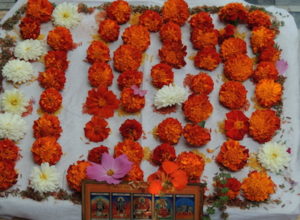 As Shailaputri, daughter of the mountains, known as Sati, Parvati, Hemavati, she is the first among the Navadurgas to be worshipped on the first day of Navaratri. She is worshipped on the second day as Bharmacharini , who practices austerity and is the path to Moksha. Chandraghanta is worshipped on the third day for peace, tranquility and prosperity in life.
As Shailaputri, daughter of the mountains, known as Sati, Parvati, Hemavati, she is the first among the Navadurgas to be worshipped on the first day of Navaratri. She is worshipped on the second day as Bharmacharini , who practices austerity and is the path to Moksha. Chandraghanta is worshipped on the third day for peace, tranquility and prosperity in life.
Kushmanda creates the universe from the void and it is her light that illumines. On the fifth day, she is worshipped as Skanda Mata, mother of Lord Kartikeya, chosen by the gods to lead them in the war against the demons. Her sixth form is Katyayani, whose father the sage Kata, did great tapasya for Katyayani to be born as an avatar of Durga.
On the seventh day, Kala Ratri is worshipped as the fierce warrior who grants fearlessness, who purifies her devotees. As Maha Gauri she is benevolent. Siddhidatri is worshipped on the ninth day of Navaratri. Devi Bhagvata Purana speaks of her worship by Lord Shiva before he assumed the form of Ardhnarishvara.
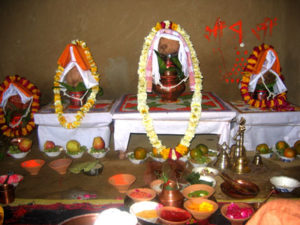 For the spiritual aspirant, the central purpose of existence is to recognise your eternal identity with the supreme Spirit, to attain union with That. Navaratri is in 3 sets of three days each, to realise different aspects of Devi or the Manifest Energy. As the first step the aspirant has to observe, recognise and resolve to be free of those elements that have become a part of his nature and behaviour in this embodied state. Then he has to consciously adopt lofty ideals and values, change behaviour and transcend nature. Gyan or knowledge and wisdom is thereby acquired.
For the spiritual aspirant, the central purpose of existence is to recognise your eternal identity with the supreme Spirit, to attain union with That. Navaratri is in 3 sets of three days each, to realise different aspects of Devi or the Manifest Energy. As the first step the aspirant has to observe, recognise and resolve to be free of those elements that have become a part of his nature and behaviour in this embodied state. Then he has to consciously adopt lofty ideals and values, change behaviour and transcend nature. Gyan or knowledge and wisdom is thereby acquired.
This process demands sankalpa, or resolved will, determined effort, and arduous struggle. The strength and power that are needed is not one’s own, but that of the Supreme. Devi reminded the gods that the glory and the power is that of Brahman alone.
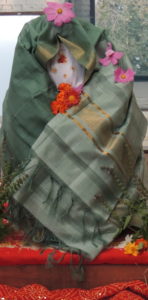 For the first three days, Devi is worshipped as Mahakali, the destructive aspect of the Mother, as the Supreme Force and Power, to destroy all impurity and negative tendencies of the mind , to annihilate all tamasic and base or animal qualities. The initial step is a ruthless, determined annihilation of the ego and the lower self. And also to seek protection from the many dangers and pitfalls of the spiritual path.
For the first three days, Devi is worshipped as Mahakali, the destructive aspect of the Mother, as the Supreme Force and Power, to destroy all impurity and negative tendencies of the mind , to annihilate all tamasic and base or animal qualities. The initial step is a ruthless, determined annihilation of the ego and the lower self. And also to seek protection from the many dangers and pitfalls of the spiritual path.
Next, is the conscious acquisition of positive qualities, of a sublime nature, of appropriate behaviour that behoves a spiritual aspirant. The aspirant must earn immense spiritual wealth to pay the price for divine wisdom. Here a steady, calm and serene effort to develop purity must be maintained. This aspect of sadhana is through the worship of Mahalakshmi.
Once satwic qualities are developed, and the predominant nature is of Satwa, the aspirant is ready to receive the light of supreme wisdom. This is through worship of Mahasaraswati, who embodies knowledge of the Absolute. The tenth day celebrates the victory, where the aspirant now resides in the Supreme Self or Satchidananda Brahman.
There are many incarnations of Durga: Kali, Bhagvati, Bhavani, Ambika, Lalita, Gauri, Rajeswari. Durga incarnated as the Shakti of Divinity with all the attributes and astras or weapons to kill the demon Mahishasur. Depicted with eight or ten hands, that represent the eight quadrants and ten directions, implying everywhere in manifestation she alone is. Also known as Triyambake, she balances solar and lunar energy, with the third eye of Gyan or wisdom. Her vahana, the lion represents power, will and determination by which the ego is slain. Devi adopts an alert, almost standing posture on the lion and displays the Abhay Mudra, which is her assurance of freedom from fear.
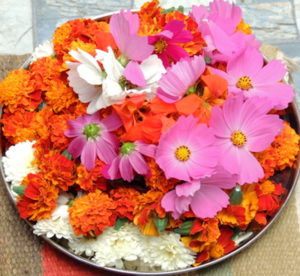 Each of her weapons have a spiritual significance:
Each of her weapons have a spiritual significance:
- The shankha or conch shell in Durga’s hand symbolizes the Pranava or Nada Brahman.
- The bow and arrows represent energy. By holding both in one hand it indicates her control over both aspects of energy – potential and kinetic.
- The vajra or thunderbolt signifies firmness. The thunderbolt can destroy anything against which it strikes, without being affected itself.
- The padma or lotus in Durga’s hand is not in full bloom, symbolizing certainty of success but not finality. For the aspirant, the lotus stands for continuous evolution of spiritual quality amidst a world of lust and greed.
- The Sudarshan-Chakra that spins around the index finger of the Goddess, without touching it, signifies that the entire world is subservient to the will of Durga and is at her command. The chakra signifies the power to destro y evil and promote righteousness.
- The sword that Durga holds in one of her hands symbolizes knowledge, which is sharp as the razor’s edge. And so too is the spiritual path.
- Durga’s trishul is a symbol of the three gunas – Satwa, Rajas and Tamas. The trishul in Devi’s hands contains the combined shakti of Mahakali, Mahalaksmi, Mahasaraswati, or Vaishnavi, Shaivi and Brahmi Shakti. It represents the manifest energy of all creation.
Apart from the ritual worship of Navdurga, and the spiritual aspirants worship of Mahakali, Mahalakshmi and Mahasaraswati, the Navaratri is observed through the worship of the Das Mahavidyas, or the Wisdom Godesses, who are worshipped by advanced practitioners, who have already attained a familiarity and known the grace of Devi, who are practiced in overcoming fear, who have firmly resolved to surrender ego or I-consciousness, who have resolved to surrender their every breath in dedication and devotion to the Supreme Being.

Thank you for this comprehensive view of Navratri and the insight into all aspects of it.